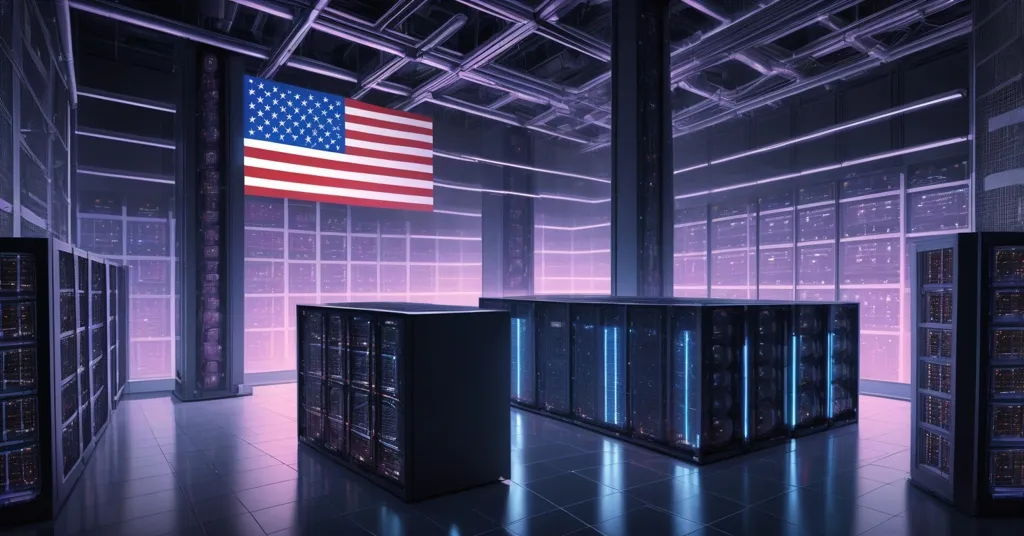OpenAI’s Energy Push vs. China: Impact on Bitcoin Mining and Blockchain Power Struggle

OpenAI’s Energy Crusade in AI Race Against China: A Power Struggle for Bitcoin and Blockchain
OpenAI has dropped a bombshell on the White House, demanding a massive ramp-up in US energy infrastructure to keep pace with China in the artificial intelligence (AI) arms race—a move that could reshape the battlefield for Bitcoin mining and blockchain innovation. As electricity becomes the new currency of technological dominance, the stakes couldn’t be higher for both AI giants and crypto pioneers.
- Energy Emergency: OpenAI pushes for 100 gigawatts of new US power capacity annually to fuel AI growth.
- US-China Gap: China added 429 gigawatts recently, while the US lags with just 51 gigawatts.
- Crypto Collision: Bitcoin mining’s energy hunger mirrors AI’s, sparking questions about power priorities and innovation.
The Electron Gap: A Wake-Up Call for Tech Dominance
On October 27, 2025, OpenAI submitted an 11-page document to the White House Office of Science and Technology Policy, laying out a dire warning: the US is falling behind China in the race for technological supremacy, not because of code or talent, but due to a crippling shortage of raw power. They’ve coined this disparity the “electron gap,” and the numbers are stark. While China added 429 gigawatts of new power capacity in a recent push, the US managed a paltry 51 gigawatts. OpenAI’s solution, as detailed in their urgent plea, is to build 100 gigawatts of new capacity every single year to support the voracious energy demands of AI data centers. To put that in perspective, just 10 gigawatts is enough to power roughly 8 million American homes annually, according to the Energy Information Administration. For more on their push, check out the full context of OpenAI’s call for expanded US power capacity.
This isn’t just about keeping the lights on for chatbots and image generators. AI infrastructure, much like Bitcoin mining, relies on massive computational resources housed in data centers that guzzle electricity non-stop. OpenAI’s partnership with Nvidia, the titan of graphics processing units (GPUs), drives home the scale of this challenge. They’re planning a project that requires 10 gigawatts alone to support AI chip development, with Nvidia potentially pouring up to $100 billion into OpenAI for sprawling data centers. Nvidia’s CEO Jensen Huang called it a “huge project,” breaking it down to a staggering 4-5 million GPUs—enough computing muscle to rival millions of high-end gaming rigs running 24/7. The market reacted instantly, with Nvidia’s shares spiking nearly 4%, adding $170 billion to its value, pushing it toward a $4.5 trillion valuation.
“Electrons are the new oil.” – OpenAI
This isn’t mere rhetoric. Electricity is the lifeblood of modern tech, fueling everything from AI algorithms to blockchain networks. Without it, the US risks ceding ground to China, whose state-driven energy expansions are outpacing American efforts by a country mile. Even beyond OpenAI, the urgency is palpable. Apple recently began shipping AI servers from Houston, Texas, as part of a $600 billion investment in US manufacturing and advanced tech. Their COO Sabih Khan highlighted that these servers will power “Apple Intelligence and Private Cloud Compute services” set for an imminent rollout. President Donald Trump jumped on the bandwagon, praising Apple and urging other tech giants to bolster domestic production.
“The new servers will power Apple Intelligence and Private Cloud Compute services, set to be unveiled soon.” – Apple COO Sabih Khan
Bitcoin Mining and AI: Competing for Power in the US
While AI giants like OpenAI clamor for more juice, Bitcoin miners are no strangers to this energy battlefield. For those new to the space, Bitcoin operates on a system called Proof-of-Work, a global math contest where miners use powerful computers to solve complex puzzles, securing the network and earning Bitcoin rewards in the process. It’s a decentralized fortress, but it comes at a cost—energy consumption that often rivals entire nations. Estimates peg the Bitcoin network’s annual draw at around 150 terawatt-hours, comparable to mid-sized countries like Argentina. So, when OpenAI talks about an “electron gap,” it hits close to home for crypto enthusiasts who’ve long faced scrutiny over mining’s power hunger.
Historically, Bitcoin mining has been a lightning rod for energy debates. In 2021, China banned mining operations, displacing over 50% of the global hashrate—essentially the total computing power securing the network. Miners flocked to energy-rich US regions like Texas, ironically the same state where Apple now hubs its AI servers. This geographic overlap isn’t just coincidence; it’s a sign of how energy infrastructure shapes tech’s frontier. If the US heeds OpenAI’s call to supercharge capacity, Bitcoin miners could ride the wave of new power grids. But there’s a catch—will policymakers prioritize AI, a darling of national security and economic growth, over crypto, often painted as a speculative wild west?
Geopolitical Stakes: Energy as the New Battleground
Zoom out, and this energy crusade reveals a deeper geopolitical chess game. The US-China rivalry isn’t just about AI chips or blockchain protocols; it’s about who controls the resources to power them. China’s digital yuan and state-controlled tech ecosystem stand in stark contrast to Bitcoin’s anarchic, borderless ethos. If electricity is the new oil, then power grids are the new oil fields—strategic assets in a high-stakes war. For Bitcoin maximalists, this is a sobering reminder that true decentralization isn’t just about running nodes; it’s about energy independence. Without it, even the most trustless network remains tethered to centralized grids and political whims.
China’s lead in power capacity isn’t just a number—it’s execution. Their centralized, state-driven model churns out infrastructure at a pace the US, bogged down by fragmented grids and bureaucratic red tape, can’t match. Scaling 100 gigawatts annually isn’t a plug-and-play fix; it’s a slog through permits, environmental backlash, and billions in capital. If energy costs spike or supply chains for Nvidia’s GPUs falter, AI’s growth could stall—and any spillover benefits for Bitcoin miners might vanish faster than a rug pull on a shady altcoin.
Energy Solutions: Can Renewables Save the Day?
Let’s not paint this as a doom-and-gloom scenario. There’s room for optimism if innovation kicks into high gear. Bitcoin miners have already started pivoting to greener grids to dodge regulatory heat. According to the Bitcoin Mining Council, about 60% of surveyed miners used renewable energy sources as of 2023. Projects like TeraWulf’s zero-carbon mining facility in Pennsylvania, powered partly by nuclear energy, hint at what’s possible. Could a US energy boom, spurred by AI demands, accelerate off-grid or nuclear-powered mining hubs? It’s a long shot, but not unthinkable—especially with effective accelerationism pushing us to build faster and bolder.
Altcoins and other blockchains offer a different perspective. Ethereum, for instance, slashed its energy footprint by over 99.9% after its 2022 Merge to Proof-of-Stake, a consensus mechanism that replaces energy-intensive mining with staking coins for network security. While Bitcoin’s battle-tested Proof-of-Work remains the gold standard for trustless security—energy be damned—Ethereum’s pivot shows how blockchain can adapt. Leaner layer-1s like Solana could also carve out niches if Bitcoin miners get squeezed by AI’s power grab. Still, for purists, Bitcoin’s unyielding design is non-negotiable, a bastion of resilience no altcoin can match.
Playing Devil’s Advocate: Is This Really About National Interest?
Before we get too cozy with OpenAI’s rallying cry, let’s flip the script. Is their push for a US energy surge truly about national competitiveness, or is it a corporate power play dressed in patriotic garb? Massive data centers and $100 billion deals with Nvidia smell like a bid for market dominance as much as a geopolitical win. If policymakers buy in, prioritizing AI over other sectors, crypto’s already shaky regulatory standing could take another hit. Bitcoin miners, often scapegoated for grid strain, might face tighter restrictions as AI gets the red-carpet treatment. And let’s not forget—centralized energy grids, even expanded ones, clash with the decentralized ideals of blockchain. Are we trading one form of control for another?
What’s Next for Crypto in the Energy Race?
The intersection of AI and crypto energy demands is a crucible for the future of tech. OpenAI’s crusade is a nod to the accelerationist drive to build bigger and better, no matter the obstacles. But freedom—whether through AI’s democratized intelligence or Bitcoin’s borderless money—comes wired to the grid, subject to politics and scarcity. The US faces a stark choice: supercharge its energy game or risk losing the future to China. For crypto, it’s a chance to hitch a ride on expanded capacity or get drowned out by the hum of AI servers. If we’re not careful, we might just swap one centralized beast for another. Let’s hope the push for power sparks real disruption, not just a new set of overlords.
Key Takeaways and Critical Questions
- Why is energy so pivotal to both AI and crypto?
AI data centers and Bitcoin mining are energy hogs, relying on vast electricity to drive computation and secure networks, making power infrastructure a linchpin for growth in both sectors. - Can the US bridge the ‘electron gap’ with China?
It’s feasible with aggressive investment and policy overhaul, but bureaucratic inertia and political gridlock could stall progress against China’s rapid, state-driven expansions. - Will Bitcoin mining gain from AI-driven energy boosts?
Possibly, if new capacity trickles down to miners, but AI’s prioritization might sideline crypto or trigger harsher regulations on energy-intensive operations. - Should Bitcoin consider energy-efficient models like Ethereum’s Proof-of-Stake?
It’s an option to reduce scrutiny, yet Bitcoin’s security hinges on Proof-of-Work, making a shift unlikely without compromising its core trustless design. - Could prioritizing AI over crypto undermine decentralization?
Absolutely, as centralized energy grids and policy focus on AI could marginalize blockchain’s ethos, pushing the need for off-grid, independent solutions in crypto.



